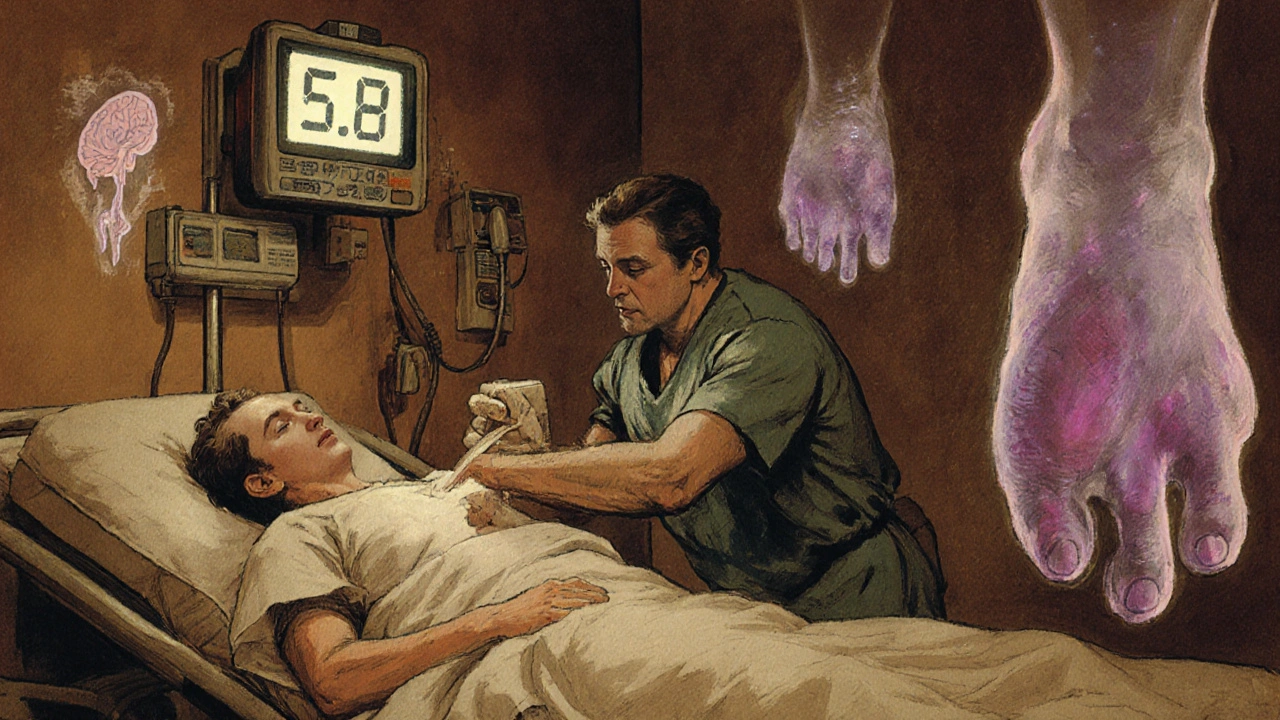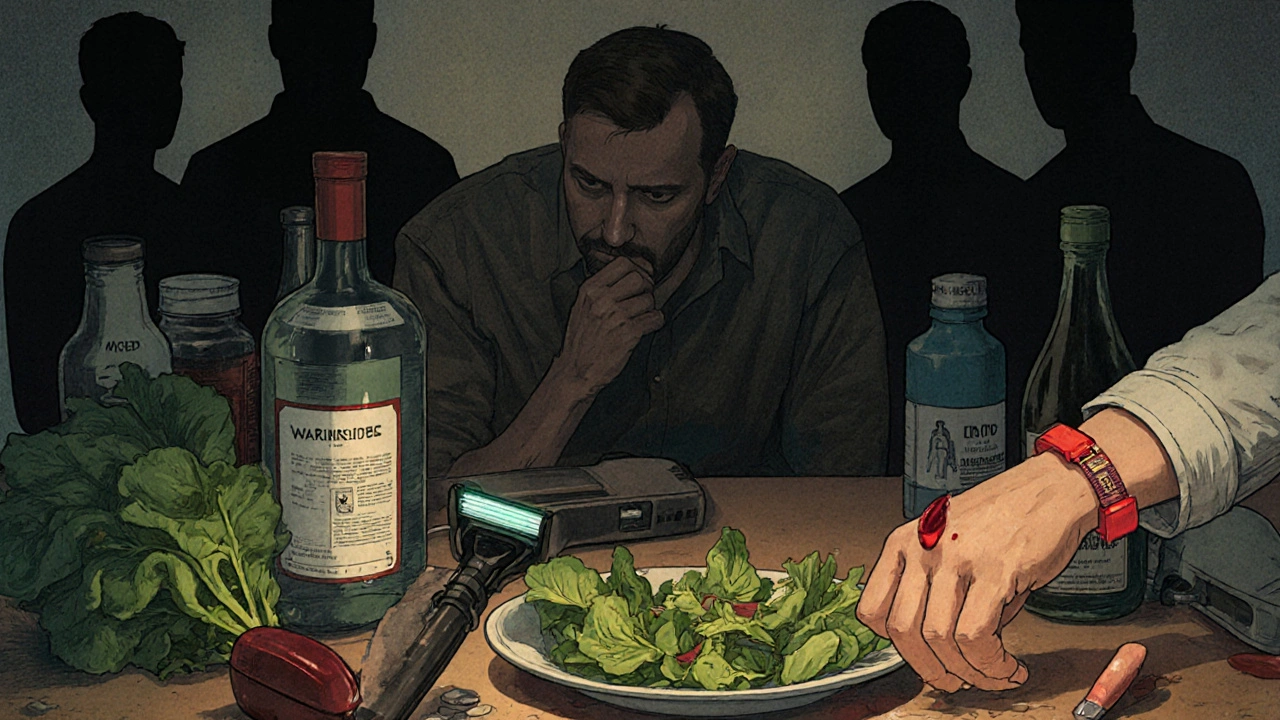Warfarin Bleeding Risk Calculator
Your Bleeding Risk Assessment
This tool calculates your bleeding risk using the HAS-BLED scoring system based on your medical history and lifestyle. Your risk level will help determine appropriate monitoring and precautions.
Warfarin has been used for over 70 years to prevent dangerous blood clots. It’s one of the most common blood thinners prescribed in the U.S., with millions of prescriptions filled every year. But while it saves lives, it also carries a serious risk: uncontrolled bleeding. If you’re taking warfarin-or considering it-you need to understand what’s normal, what’s dangerous, and exactly what to do if something goes wrong.
Why Warfarin Works (and Why It’s Risky)
Warfarin blocks vitamin K, which your body needs to make clotting factors. Less clotting = fewer dangerous clots in your legs, lungs, or brain. That’s why it’s used for atrial fibrillation, deep vein thrombosis, and after mechanical heart valve replacements. But here’s the catch: the line between too little and too much is razor-thin. Too little, and you’re still at risk for stroke. Too much, and even a minor bump can lead to internal bleeding.
The key to staying safe? Keeping your INR (International Normalized Ratio) in the right range. For most people, that’s between 2.0 and 3.0. If you have a mechanical mitral valve, your target might be higher-2.5 to 3.5. When your INR goes above 4.0, your risk of major bleeding doubles. At INR 5.0 or higher, the chance of a serious bleed is nearly 1 in 4 per year.
The Most Common Bleeding Signs (Don’t Ignore These)
Bleeding from warfarin doesn’t always come from a cut. Sometimes, it’s silent. Here’s what to watch for:
- Nosebleeds that last more than 5 minutes, even after pinching your nose
- Gums that bleed easily when brushing or flossing
- Unexplained bruising-especially large, dark patches with no injury
- Pink, red, or brown urine
- Black, tarry, or bloody stools
- Vomiting blood or material that looks like coffee grounds
- Sudden, severe headache, dizziness, or weakness
- Back pain that comes out of nowhere
- Vaginal bleeding that’s heavier than normal or happens between periods
If you notice any of these, call your doctor immediately. For severe symptoms like coughing up blood, confusion, or vision changes, go to the ER. Time matters. A brain bleed caused by warfarin can become fatal within hours if not reversed quickly.
What Happens When Bleeding Gets Serious?
Doctors have a clear plan for major bleeding. First, they stop warfarin. Then they reverse it. The fastest way? Prothrombin complex concentrate (PCC). It works in minutes. If PCC isn’t available, fresh frozen plasma is used-but it takes longer. Vitamin K is given too, but it takes 12 to 24 hours to work, so it’s not for emergencies.
For intracranial hemorrhage (bleeding in the brain), guidelines say reversal must happen within 30 to 60 minutes. Delayed treatment increases death risk by over 50%. That’s why knowing your INR and having it checked regularly isn’t optional-it’s life-saving.

Other Side Effects You Might Not Expect
Bleeding is the biggest concern, but warfarin has other rare but serious side effects:
- Warfarin-induced skin necrosis: This is rare-about 1 in 10,000 people-but terrifying. It causes painful, dark patches of skin to die, usually within days of starting the drug. It’s linked to low protein C levels and can lead to amputation if not caught early.
- Purple toe syndrome: Small cholesterol crystals block tiny blood vessels in your toes. Your toes turn purple, feel sore, and may become numb. It usually shows up 3 to 8 weeks after starting warfarin.
- Calciphylaxis: Extremely rare, mostly in people with kidney failure. Calcium builds up in blood vessels, causing painful skin ulcers and tissue death.
Less serious side effects like nausea, bloating, or a weird taste in your mouth are common but usually harmless. Still, if they’re new or getting worse, mention them to your doctor.
Who’s at Highest Risk for Bleeding?
Not everyone on warfarin has the same risk. Some people are much more likely to bleed. Here’s who’s most vulnerable:
- Age 65 or older (risk jumps 2.5 times)
- History of stomach bleeding (3.1 times higher risk)
- High blood pressure (2.8 times higher risk)
- Previous stroke or brain bleed
- Severe kidney or liver disease
- Low red blood cell count (anemia)
- Cancer
If you have three or more of these, your annual bleeding risk can hit 20%. That’s why doctors use tools like the HAS-BLED score to assess your risk before prescribing. If your score is high, they may consider switching you to a newer blood thinner.
Diet, Drugs, and Daily Life: What to Avoid
Warfarin doesn’t just interact with other meds-it reacts to what you eat and do.
Food: Vitamin K is your enemy here-not because it’s bad, but because it fights warfarin. Leafy greens like spinach, kale, and broccoli are packed with it. The key? Don’t change how much you eat. If you normally eat a salad every day, keep doing it. If you never eat greens, don’t suddenly start. A daily intake of 60-80 mcg of vitamin K is ideal. A sudden 100 mcg spike can drop your INR by 0.5 to 1.0 point-enough to make your blood too thick.
Medications: Over 300 drugs interact with warfarin. Common ones include:
- NSAIDs like ibuprofen and naproxen (doubles GI bleeding risk)
- Antibiotics like amoxicillin and ciprofloxacin
- Antifungals like fluconazole
- Herbs like ginkgo, garlic, and St. John’s wort
- Many OTC cold and pain meds
Always check with your doctor or pharmacist before taking anything new-even a single dose of Advil.
Lifestyle: Avoid contact sports, heavy lifting, and activities with high fall risk. Use an electric razor, not a blade. Brush with a soft-bristle toothbrush and use waxed floss. Wear a medical alert bracelet. Carry a card that says you’re on warfarin. If you’re in an accident and unconscious, this could save your life.

When Should You Consider Switching to a Newer Blood Thinner?
Newer drugs like apixaban (Eliquis), rivaroxaban (Xarelto), and dabigatran (Pradaxa) don’t require INR checks, have fewer food interactions, and cause about 30% fewer major bleeds than warfarin. But they’re not for everyone.
Warfarin is still the best choice if you have:
- A mechanical heart valve (especially in the mitral position)
- Severe kidney failure (eGFR below 15)
- Antiphospholipid syndrome with prior clots
If you’re younger, have no major kidney issues, and can’t handle frequent blood tests, a DOAC might be better. Talk to your doctor. Your risk profile, lifestyle, and preferences matter.
How to Stay Safe on Warfarin
Here’s your practical checklist:
- Get your INR tested every 4 weeks if stable-more often if your dose changes or you’re sick.
- Eat consistent amounts of vitamin K-rich foods. Don’t go on a kale diet one week and none the next.
- Never start or stop any medication, supplement, or herb without checking with your doctor.
- Use a soft toothbrush and electric razor.
- Avoid NSAIDs. Use acetaminophen (Tylenol) for pain if needed.
- Wear a medical alert bracelet or carry a card.
- Know your INR target and what your last result was.
- Call your doctor immediately if you notice any bleeding signs.
Warfarin isn’t dangerous because it’s bad. It’s dangerous because it’s powerful. And power demands respect. With careful management, it’s one of the safest and most effective tools we have to prevent strokes and clots. But you have to be the quarterback of your own care. Know your numbers. Know your risks. Know what to do.
Can I drink alcohol while taking warfarin?
Moderate alcohol (one drink per day) is usually okay, but heavy drinking increases your bleeding risk and can make your INR unstable. Alcohol affects how your liver processes warfarin, so even small changes in how much you drink can throw off your dose. If you drink, keep it consistent-and tell your doctor.
What should I do if I miss a dose of warfarin?
If you miss a dose and remember within 8 hours, take it right away. If it’s been longer, skip the missed dose and take your next dose at the regular time. Never double up. Missing doses can make your blood too thick, increasing stroke risk. Taking extra can make it too thin, raising bleeding risk. Always check with your doctor if you’re unsure.
Can I get a tattoo or piercing while on warfarin?
It’s not recommended. Tattoos and piercings involve breaking the skin and carry a high risk of prolonged bleeding and infection. If you really want one, talk to your doctor first. They may check your INR and suggest holding warfarin temporarily-but only if your condition allows it. Most providers advise against it entirely.
Do I need to avoid all leafy greens?
No. You don’t need to avoid them-you need to keep your intake steady. If you eat spinach every day, keep doing it. If you never eat it, don’t start suddenly. The problem isn’t vitamin K itself-it’s inconsistency. Fluctuations in your vitamin K intake cause your INR to swing, making your warfarin dose unpredictable.
Is it safe to take warfarin during dental work?
For routine cleanings or fillings, you usually don’t need to stop warfarin. Dentists can use local hemostatic agents to control bleeding. For major surgery like extractions or implants, your doctor may check your INR and decide whether to pause warfarin temporarily. Never stop it on your own. Bridging with injections is rarely needed anymore unless you’re at very high risk for clots.
Final Thought: Warfarin Isn’t the Problem-Lack of Control Is
Warfarin isn’t outdated. It’s not unsafe. It’s just unforgiving. It demands attention. It needs consistency. It requires you to be an active participant in your care. If you’re willing to test your INR, track your diet, and communicate with your team, it can keep you safe for decades. If you ignore the warnings, skip tests, or take random pills, the risk skyrockets. The choice isn’t between warfarin and safety-it’s between managing it well or letting it manage you.


Write a comment